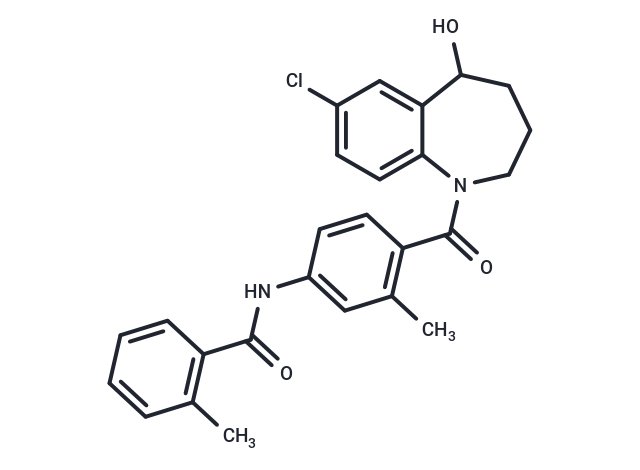Shopping Cart
- Remove All
 Your shopping cart is currently empty
Your shopping cart is currently empty

Tolvaptan (OPC-41061) is an orally bioavailable, selective, arginine vasopressin receptor 2 (V2, AVPR2) antagonist that can be used to treat hyponatremia.

| Pack Size | Price | Availability | Quantity |
|---|---|---|---|
| 1 mg | $32 | In Stock | |
| 2 mg | $45 | In Stock | |
| 5 mg | $74 | In Stock | |
| 10 mg | $117 | In Stock | |
| 25 mg | $217 | In Stock | |
| 50 mg | $383 | In Stock | |
| 1 mL x 10 mM (in DMSO) | $129 | In Stock |
| Description | Tolvaptan (OPC-41061) is an orally bioavailable, selective, arginine vasopressin receptor 2 (V2, AVPR2) antagonist that can be used to treat hyponatremia. |
| Targets&IC50 | V2 receptor:3 nM |
| In vitro | Tolvaptan reduces the pre-cardiac load in dogs with heart failure without adversely affecting renal function, systemic hemodynamics, or circulating neurohormones. In animal models of human polycystic kidney disease, Tolvaptan leads to a reduction in kidney weight and a decrease in cyst fibrosis and volume. Furthermore, Tolvaptan improves hyponatremia and prevents mortality in rat models of acute and chronic hyponatremia. In rats with heart failure, Tolvaptan significantly increases electrolyte-free water clearance (E-CH(2)O) and enhances the excretion of urinary arginine vasopressin. |
| In vivo | Tolvaptan demonstrates a concentration-dependent inhibition of arginine vasopressin (AVP)-induced cAMP production in cells affected by Autosomal Dominant Polycystic Kidney Disease (ADPKD), with an IC50 of 0.1 nM. It also suppresses AVP-induced ERK signaling and cell proliferation. Furthermore, Tolvaptan inhibits the secretion of chloride (-) induced by AVP and reduces the extracellular growth of cysts in ADPKD cells cultured in a three-dimensional collagen matrix. It inhibits the binding of [(3)H] AVP to human V(2) receptors with 29 times greater selectivity compared to the V(1a) receptor while showing no inhibitory effect on the V(1b) receptor. In HeLa cells induced by AVP, Tolvaptan inhibits not only the binding of [(3)H] AVP but also the expression of cyclic AMP. |
| Kinase Assay | Cell-free autophosphorylation assay using time-resolved fluorometry: Neratinib is prepared as 10 mg/mL stocks in DMSO and diluted in 25 mM HEPES (pH 7.5; 0.002 ng/mL-20 μg/mL). Purified recombinant COOH-terminal fragments of HER2 (amino acids 676-1255) or epidermal growth factor receptor (EGFR) (amino acids 645-1186) [diluted in 100 mM HEPES (pH 7.5) and 50% glycerol] is incubated with increasing concentrations of Neratinib in 4 mM HEPES (pH 7.5), 0.4 mM MnCl2, 20 μM sodium vanadate, and 0.2 mM DTT for 15 minutes at room temperature in 96-well ELISA plates. The kinase reaction is initiated by the addition of 40 μM ATP and 20 mM MgCl2 and allowed to proceed for 1 hour at room temperature. Plates are washed, and phosphorylation is detected using Europium-labeled anti-phospho-tyrosine antibodies (15 ng/well). After washing and enhancement steps, signal is detected using a Victor2 fluorescence reader (excitation wavelength 340 nm, emission wavelength 615 nm). The concentration of Neratinib that inhibits receptor phosphorylation by 50% (IC50) is calculated from inhibition curves. |
| Alias | OPC-41061 |
| Molecular Weight | 448.94 |
| Formula | C26H25ClN2O3 |
| Cas No. | 150683-30-0 |
| Smiles | C(=O)(N1C=2C(=CC(Cl)=CC2)C(O)CCC1)C3=C(C)C=C(NC(=O)C4=C(C)C=CC=C4)C=C3 |
| Relative Density. | 1.311 g/cm3 |
| Storage | Powder: -20°C for 3 years | In solvent: -80°C for 1 year | Shipping with blue ice. | |||||||||||||||||||||||||||||||||||
| Solubility Information | Ethanol: 4.5 mg/mL (10.02 mM), Sonication is recommended. DMSO: 40 mg/mL (89.1 mM), Sonication is recommended. | |||||||||||||||||||||||||||||||||||
Solution Preparation Table | ||||||||||||||||||||||||||||||||||||
Ethanol/DMSO
DMSO
| ||||||||||||||||||||||||||||||||||||

Copyright © 2015-2025 TargetMol Chemicals Inc. All Rights Reserved.